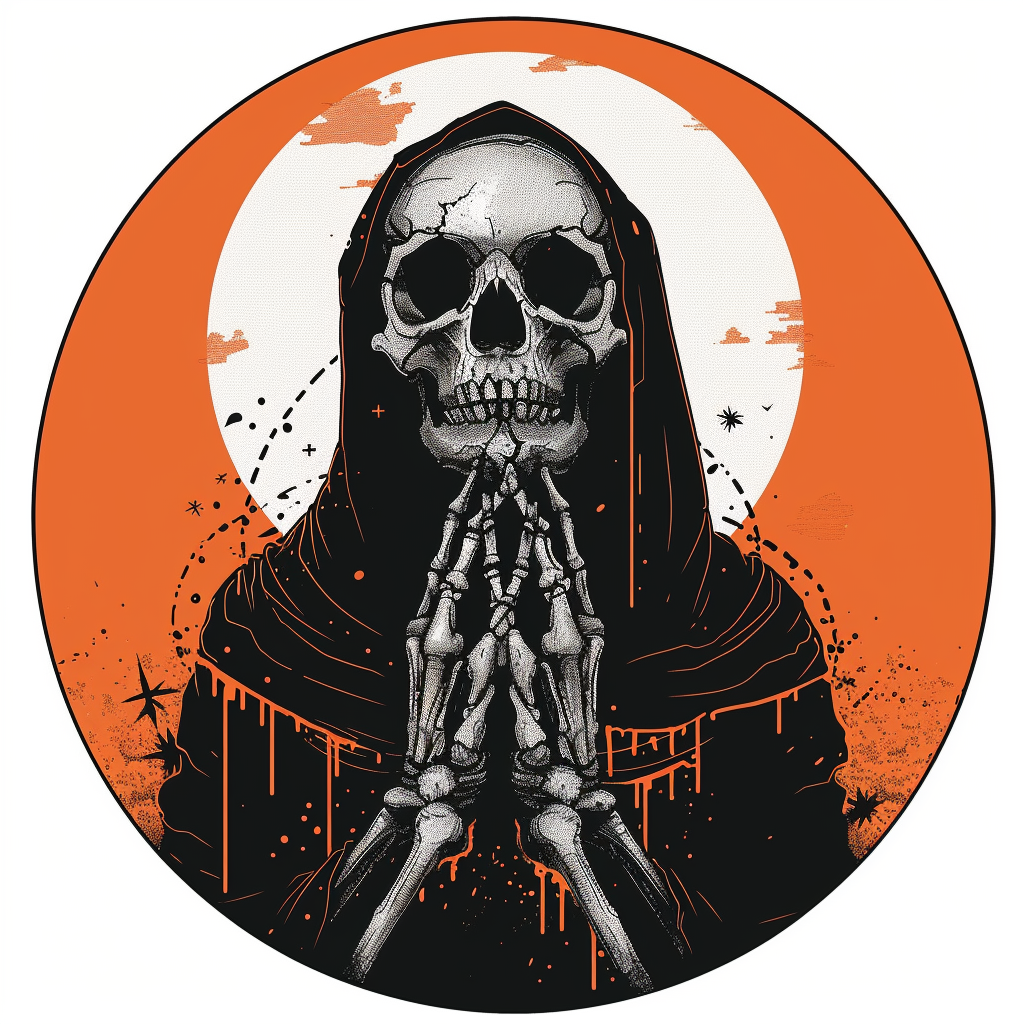How to Manifest Death: A Silly Guide to a Not-So-Silly Topic
Looking to manifest death? You’re in the right place, although this task may sound like something straight out of a Halloween special. Manifesting death, by the way, involves focusing energy and intent towards causing a permanent cessation of life. It’s like ordering a pizza but way more morbid and without the delicious aftertaste.
So, how exactly does one go about this grim business? It’s not as simple as waving a wand or chanting Latin phrases from a dusty old book. To do this, one needs a clear intention, unwavering focus, and possibly some questionable ethics. Think of it as a really bad camping trip: things might get dark and you’ll have to face some pretty weird stuff to reach the end.
Don’t expect instant results; after all, Rome wasn’t built in a day, and neither is a homemade demise. One has to be committed, patient, and possibly a little unhinged.

Unveiling the Mystery: What Does ‘Manifesting Death’ Mean?
When it comes to “manifesting death,” things can get pretty bizarre. We’ll break down what this odd phrase entails, and why on Earth anyone would want to talk about it.
Deciphering the Lingo: Manifestation and Mortality
The term “manifesting death” isn’t as grim as it sounds. Manifestation is the act of bringing something into reality through belief and intention. When linked to mortality, it involves the existential ideas surrounding the end of life.
Some people might think it means predicting death, while others might see it as a way of coming to terms with the inevitable. Think of it as a spiritual “Google Calendar” for the soul, marking the final event we all eventually attend. Manifesting death often sits at the intersection of philosophy, psychology, and sometimes, a spooky kind of self-help.
Why on Earth Are We Even Talking About This?
Death is a universal experience but remains one of the least understood phenomena. Discussing manifesting death can help demystify the fears and superstitions surrounding the topic. It’s like the adult version of flipping on a light switch to scare away the monsters under your bed.
In modern culture, the concept has also gained traction through various self-help and spiritual platforms. Some claim it helps people live more authentically, knowing that their time is finite. Others consider it a morbid fascination or a way to deal with anxiety about the unknown.
The Ethical Dilemma: Is It Morbid, or Just Misunderstood?
Is manifesting death a grim fascination, or is it a misunderstood avenue for deeper existential exploration? This section explores the moral intricacies and engages the conscience in a thoughtful dialogue.
Navigating the Moral Compass
When pondering the ethics of manifesting death, one must first dust off the moral compass. Is it pointing north, or does it look broken? The ethical questions are many: Does focusing on death invariably lead to dark thoughts? Or can it be a tool for appreciating life more?
Ethicists argue that intention matters. The quest might be about understanding life’s transient nature rather than morbid fascination.
Imagine someone conducting a symphony of self-reflection, contemplating mortality as the crescendo, rather than a grim reaper with a checklist. Striking the right balance between curiosity and respect becomes paramount.
One should weigh personal motivations and societal impact. If the objective is to cultivate mindfulness and appreciation for life, then the moral compass might tilt towards acceptance rather than condemnation.
A Chat with Your Conscience
Engaging in self-dialogue about manifesting death might sound like a quirky therapy session. Picture sitting down with a cup of coffee and having a heart-to-heart with your own ethical muscle. Is this a macabre fixation, or just a way to grapple with inevitable reality?
During this inner chat, consider how your actions affect yourself and others. Does it promote existential wisdom or unnecessary gloom? Contemplating mortality might be valuable if it leads to a better, more intentional way of living.
Keeping intentions transparent helps align with ethical boundaries. If the goal is to deepen one’s appreciation of life, acknowledging this aim can make it a noble pursuit rather than a morbid obsession.
Literary Limbo: How Fiction Handles the Hefty Topic
Fiction often explores death in intriguing ways, using different characters and plot devices. Classic works and modern tales alike build rich, imaginative landscapes around the theme of death.
From Shakespeare to Stephen King
Death has been a dramatic focal point for many notable authors. Shakespeare’s Hamlet wrestles with the concept through the iconic “To be or not to be” soliloquy. Here, the character grapples with mortality’s existential dilemmas, pondering the unknowns of the afterlife.
Fast forward to Stephen King. In Pet Sematary, death’s horror is embodied quite literally. The narrative pushes boundaries, reflecting societal fears about what lies beyond. King’s vivid descriptions make death a tangible, terrifying presence. Both writers use death to engage readers deeply, questioning comfort and certainty.
Plot Twists and The Grim Reaper
Fiction often employs plot twists involving death to captivate and shock readers. George R.R. Martin’s Game of Thrones isn’t shy about killing beloved characters. Each unexpected demise keeps readers on their toes, highlighting life’s fragile nature.
Or consider Neil Gaiman’s The Sandman. Death appears not as a grim figure but as a quirky, engaging character. This unique portrayal demystifies death and adds layers of intrigue. Transforming death into plot elements or characters helps authors create memorable, gut-wrenching, or even humorous moments.

The Power of Words: Affirmations versus Curses
Words shape our experiences and interactions. They can lift us up or drag us down. Let’s explore how affirmations and curses affect us.
Speaking Things into Existence (Or Not)
He says, “I am wealthy,” while secretly clutching a nearly empty wallet. She mutters, “I am loved,” while dodging her cat’s side-eye. Affirmations are positive statements aimed at changing one’s mindset, offering a rosier perspective on life’s daily grind.
Affirmations can rewire our thinking. Repeating phrases like “I am confident” or “I attract success” can condition the brain to consider these concepts as reality. This boosts self-esteem and motivation.
On the flip side, empty affirmations can become as effective as trying to use a chocolate teapot. Reality tends to poke holes in those who loudly proclaim abundance while staring down an empty fridge. So, affirmations work best with a sprinkle of genuine belief and a dash of action.
The Fine Line Between ‘Oops’ and ‘Oh No’
Now, let’s talk curses. Imagine grumbling, “I have the worst luck,” right before stepping in a puddle. It’s like life saw your complaint and said, “Challenge accepted!” Curses, or negative statements, carry the potential to spiral one’s day or even longer into an abyss of misfortune.
Curses can be self-fulfilling prophecies. Saying, “I always fail,” may lead to a mindset soaked in defeat. This negative spiral affects both performance and the inclination to even try, creating a loop of despair.
Accidentally cursing oneself or others with a careless “I wish you’d disappear” can sometimes feel like you’ve tossed a tiny rock into a big pond—ripples may come back to splash you. Magic or not, it’s just good manners (and sanity) to keep negative chatter to a minimum.
Talk affirmatively, but mean it. Curse less, if at all. No one needs more puddles anyway.
Cultural Views on Death and Its Manifestation
Different cultures approach death and its manifestation with unique rituals and beliefs. From elaborately decorated graves to vibrant celebrations, these customs reflect diverse ways of honoring and dealing with the inevitable end of life.
Around the World in 80 Graves
Graves speak the silent language of history. In Egypt, the ancient pyramids house the mummified remains of pharaohs, meant to ensure their passage to the afterlife. Meanwhile, in Japan, graves are surrounded by paper lanterns during Obon, guiding ancestors back to the living world.
In Mexico, vibrant altars decorated for Día de los Muertos invite the deceased back to enjoy their favorite foods and items. Often considered a joyful celebration, this contrasts starkly with the solemnity seen in Victorian England, where mourning attire and strict etiquette marked the period after a death.
In Ghana, colorful and elaborately designed coffins celebrate a person’s passions or profession, turning funerals into a final showmanship of their life.
Festivities and Farewells
In Bali, cremation ceremonies are both communal and theatrical, with lively music and dance ensuring the spirit’s release. These ceremonies are thought to purify the soul and help it find its way to the next life, transforming death into a festive occasion.
In Madagascar, the Famadihana or “turning of the bones” involves exhuming ancestors, rewrapping them in fresh cloth, and dancing with the bones. This practice reinforces social ties and strengthens familial bonds through multiple generations.
New Orleans jazz funerals fuse somber hymns with upbeat jazz tunes. This blend symbolizes the transition from mourning to celebration, reflecting the belief that death is a passage to a better place.
The Buddhist practices in Tibet include sky burials, where bodies are left for vultures. This act is seen as a compassionate return of one’s remains to nature, aiding in detachment from the physical world.
The Final Curtain: Conclusion
When conjuring up the final bow, it’s wise to do it with a flourish. The whole idea dances on the premise of intent, focus, and a dash of cosmic flair.
Thinking deeply about one’s existence is like deciding between yoga or ice cream—either can be life-changing. Yet, the outcome matters.
Manifesting the end requires one to embrace absurdity, like debating whether pineapple belongs on pizza.
It’s all serious until someone pulls out a Ouija board.
Key Ingredients:
- Ironclad Intent
- Cosmic Focus
- Unwavering Flair
These three elements form the bedrock. Juggling them is less like actual juggling and more like dropping invisible balls… and pretending it was part of the act.
One might say finding joy in the macabre is akin to discussing quantum physics at a dinosaur-themed party. Both could trigger fascinating revelations.
Avoid mundane routines. Rituals should resemble a magician’s finale, not a tedious comb-over.
Life “exiting, stage left” should include fanfare and, preferably, fewer human sacrifices.
Final Notes:
Go forth, and may your exit be as dramatic as a soap opera’s!
On the journey’s eve, just remember: the universe appreciates a good show.

